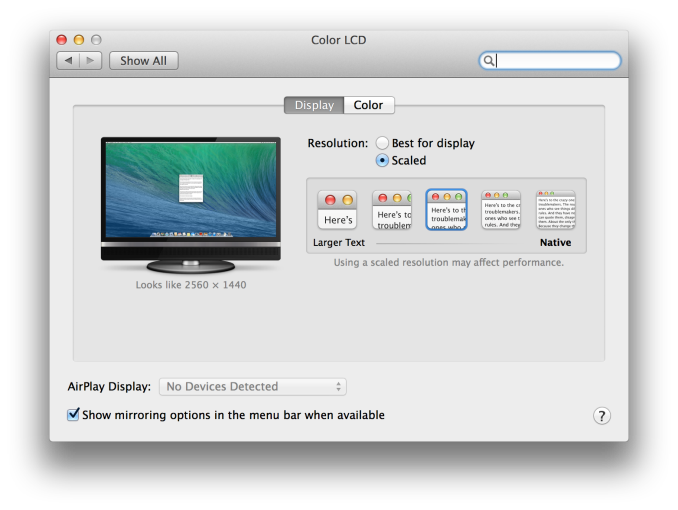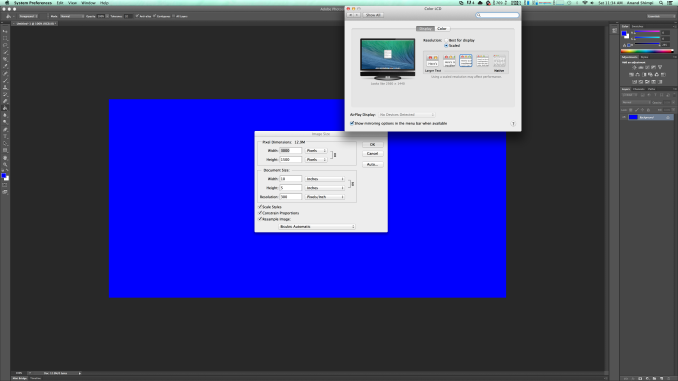Improving the State of 4K Display Support Under OS X
by Anand Lal Shimpi on March 7, 2014 11:41 PM EST- Posted in
- Mac
- Displays
- Apple
- MacBook Pro
- Mac Pro

In my Mac Pro review I lamented the state of 4K display support under OS X 10.9.0. In my conclusion I wrote: "4K display compatibility under OS X is still a bit like the wild west at this point". Compatibility was pretty much only guaranteed with the ASUS/Sharp 4K displays if you cared about having a refresh rate higher than 30Hz. Even if you had the right monitor, the only really usable resolution was 3840 x 2160 - which ends up making text and UI elements a bit too small for some users. Absent were the wonderful scaling resolutions that Apple introduced with its MacBook Pro with Retina Display. Well it looks like that won't be the case for long, last night I got reports (thanks Mike!) that the latest developer build of OS X 10.9.3 includes expanded support for 4K displays, 4K/60Hz support for rMBPs and scaled resolutions below 4K.
For starters, the list of compatible displays in 10.9.3 extends beyond the ASUS/Sharp models. The 32" and 24" Dell 4K panels are now supported, and I'm guessing the < $1K 28" 4K monitors should be supported as well. You could drive any of those panels prior to 10.9.3 but not at 60Hz.
The display preference pane now includes support for scaled resolutions just like on the rMBPs. The default in 10.9.3 is still the panel's native resolution, but you now have the option to choose 3200 x 1800, 2560 x 1440, 1920 x 1080 or 1280 x 720. All of these options are treated the same way that the rMBP's scaled resolutions are handled. In the case of the 2560 x 1440 setting, your display is rendered at 5120 x 2880 with text/UI elements drawn at 4x the size (2x in each dimension) and images/video in supported applications drawn at 1x size (1:1 pixel mapping). Once the frame is built, it's scaled down to fit the panel's 3840 x 2160 resolution - giving you a fairly sharp image. I suspect Apple is using their own filtering algorithms here as well in order to ensure maximum quality for the downscaled image.
The beauty of Apple's scaled approach is you get totally usable text/UI elements while still getting all of the benefits of having tons of screen real estate for working on images or videos. The example below features a Photoshop CS6 window with a blue box measuring 3000 x 1500 pixels with no scaling (viewport is set to 100% scale). In this particular example the display is running at the 2560 x 1440 scaled setting, but as you can see the 3000 x 1500 image can still fit on the screen without scaling or scrolling. This is only possible because the off-screen desktop resolution is a whopping 5120 x 2880 and image elements are rendered 1:1:
You'll also notice that despite the ultra high off-screen resolution, all text/UI elements appear as if they were drawn on a 2560 x 1440 display. That's the 4x scaling at work.
Prior to 10.9.3, you could force some lower-than-native resolutions on 4K panels but you'd get a lower res desktop upscaled to fit the panel, without any of the HiDPI benefits I just outlined.
There may be a performance impact to the scaled resolution settings (the 3200 x 1800 option actually draws your screen at 6400 x 3600), particularly if you're driving a 4K panel off of an rMBP but I suspect any of the beefier Mac Pro configurations should be fine. This is definitely something to look at once 10.9.3 goes final.
This is a huge step forward in improving the state of 4K under OS X. The 10.9.3 update is a smaller update than 10.9.2 (~200MB vs nearly 800MB), which took around two months from initial seeding to final release.
















32 Comments
View All Comments
Anand Lal Shimpi - Saturday, March 8, 2014 - link
Seems like that's a bug in 10.9.3, all resolutions are scaled by 2x in each dimension including the lower resolution options. Updated the post/gallery.Filmgeek47 - Tuesday, March 11, 2014 - link
Would love to see some tests focusing on the D300s and their ability to drive scaled 4k resolutions. In theory wouldn't one of these cards be able to run scaled 4k on a single display if they can drive 3 unscaled?TETRONG - Saturday, March 8, 2014 - link
Anand, judging by the comments here there seems to be some confusion about GPU's, rendering, scaling, ratios, etc..Might be a good time to do a user guide for monitor performance. A how-to guide so people are running their monitors at the correct resolutions for their specific workloads, eyesight, GPU's and other factors.
Many times in the past I've come upon users who were running at the wrong resolutions for their setup but they were reluctant to fiddle with their settings despite monitor whine(CRT's), blurry screens, and obvious GPU wailing.
Now seems like a good time to set the record straight because of the wide differences in screen technology people are encountering on a daily basis - phones to 4K panels.
Isn't Brian an expert on Optics?
solipsism - Saturday, March 8, 2014 - link
I second this.repoman27 - Sunday, March 9, 2014 - link
So I was just doing some back of the envelope calculations to figure out how much memory you'd need to store the buffer objects for rendering at 3200 x 1800 with 4xSSAA and then scaling it down to 3840x2160 for output... It seems like it would be in the neighborhood of 1.6 GB!Now imagine running 3 displays in that same scaled mode off of a new Mac Pro. The D700s with 6 GB of VRAM might be able to hang, but what about the D300s? Or even the poor IGP in the Retina MacBook Pros that lack a dGPU trying to drive the embedded panel as well as a single 4K display in the "Looks like 3200 x 1800" scaled mode? If the built-in display on a 15-inch MacBook Pro was also set to the 1920 x 1200 scaled resolution, it would be the equivalent of pushing 32,256,000 pixels (or the same as 8.75 2560 x 1440 displays)!
jollyjinx - Sunday, March 9, 2014 - link
The screen shots of the scaled resolutions are irrelevant as they are not scaled but rather the output of the virtual image. The real image on those monitors looks much more fuzzy and it defenitly shows not using either the 1:1 or the 2:1 scaling.rm19 - Sunday, March 9, 2014 - link
Might be time to render the entire OS in 3D or at least make it vector graphics based. Then you can sit back and laugh at high resolutions and scaling problems. Like this. Hahahaha!inighthawki - Sunday, March 9, 2014 - link
Graphics are rarely the issue, since things like text are often already scaled properly. the biggest issue is having a DPI aware application that properly scales its user interface.le_jean - Monday, March 10, 2014 - link
What Display are these Screenshots being made on?Any information on updated 60Hz compatibility concerning Dell's UP 2414Q?
I would be very interested to get some feedback in relation to:
nMP & Dell UP 2414Q
rMBP & Dell UP 2414Q
I remember in anandtech revue of nMP there have been issues concerning that specific display, while Sharp and ASUS performed just fine
donius - Thursday, March 13, 2014 - link
I notice there is no option for screen rotation. All the 4K displays mentioned advertise that as a feature. Does 10.9.3 not support 90-degree screen rotation for retina displays? (That's a big deal for 24" displays.)